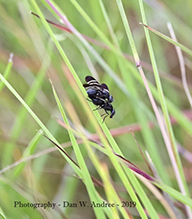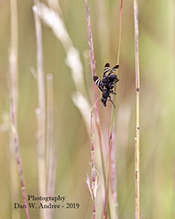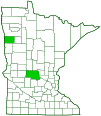black onion fly
(Tritoxa flexa)
Conservation • Description • Habitat • Ecology • Distribution • Taxonomy
Conservation Status |
|||
| IUCN Red List |
|
||
| NatureServe |
|
||
| Minnesota |
|
||
Description |
Black onion fly is a medium-sized picture-winged fly. It occurs in the United States from New Hampshire to Minnesota and south to Missouri and North Carolina. It is uncommon in Minnesota, where it is at the western extent of its range. It is a serious pest of cultivated onion and garlic crops in the Northeast and North Central states. The female is slender, ¼″ to ⅜″ (6 to 10 mm) long. The head, body, and legs are entirely black or brownish-black. The body is shiny and is covered with short hairs. The wings are dark and have three clear cross bands. The outer two bands are slightly arced. The inner band (nearest to the body) is straight and is tapered to a point near the inner margin. The upper side of wing vein R1 is covered with small hairs (setulose) at the end. The knob-like flight-balancing organs (halteres) are mostly white, black just at the base. The male is similar but smaller, 3 ⁄16″ to 5 ⁄16″ (5 to 8 mm) long. |
Size |
Female: ¼″ to ⅜″ (6 to 10 mm) Male: 3 ⁄16″ to 5 ⁄16″ (5 to 8 mm) |
Similar Species |
Habitat |
Fields, meadows |
Ecology |
Season |
Three generations: Early May through late summer |
Behavior |
|
Life Cycle |
The female lays eggs singly or in groups usually under the lowest leaf sheath, sometimes higher on the plant, sometimes in the soil near the plant. Larvae feed on the bulb. Third instar larvae overwinter within the onion bulb. The following spring they pupate in the soil within twelve inches of the base of the host plant. Adults emerge 5 to 17 days later. There are two complete and one overwintering generation each year. The generations overlap so there are adults present all summer. |
Larva Food |
Bulbs of onion and garlic |
Adult Food |
Probably flower nectar |
Distribution |
||
|
Sources |
|
| 8/28/2025 | ||
Occurrence |
||
|
||
Taxonomy |
|
Order |
|
Suborder |
Brachycera |
Infraorder |
Cyclorrhapha |
Zoosection |
Schizophora |
Zoosubsection |
Acalyptratae (acalyptrate flies) |
Superfamily |
Tephritoidea (fruit, signal, and picture-winged flies) |
Family |
Ulidiidae (picture-winged flies) |
Subfamily |
Otitinae |
Tribe |
Cephaliini |
Genus |
Tritoxa |
Subordinate Taxa |
|
|
|
Synonyms |
|
Trypeta arcuata Trypeta flexa |
|
Common Names |
|
black onion fly |
|
Glossary
Halteres
In flies: a pair of knob-like structures on the thorax representing hind wings that are used for balance.
Visitor Photos |
Share your photo of this insect. |
||
This button not working for you? |
||
Dan W. Andree |
|
Black Onion Flies They were obviously mating. It was windy out so it wasn’t easy trying to get them focused in as they would bobble back and forth in the wind. Seen a pair a few minutes after arriving onto the prairie and then another pair when leaving 3-4 hours later. There are a lot of goldenrod soldier beetles mating to now. They are very, very abundant. These photos were taken on the 13th of Aug. 2019 Frenchman’s Bluff SNA. I kind of like that area because of the big hill and views from up top and also often have the place to myself so can concentrate on subjects better without interruptions. But all prairies have life and interesting things sometimes one just has to look a little closer and even on a smaller scale for some subjects. I thought at first these were some kind of wasp, hornet or even flying ant so couldn’t find out what they were until I remembered reading something about flies have two wings and these seemed to just have 2. So I checked flies and that is where I found out what they were. Interesting and cool wing colors for a fly. |
|
 |
 |
MinnesotaSeasons.com Photos |
|

Slideshows |
|

Visitor Videos |
Share your video of this insect. |
||
This button not working for you? |
||
|
Other Videos |
|

Visitor Sightings |
Report a sighting of this insect. |
||
This button not working for you? |
||
MinnesotaSeasons.com Sightings |
|

|
Created: 9/8/2019 Last Updated: © MinnesotaSeasons.com. All rights reserved. |

